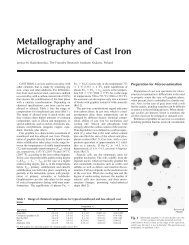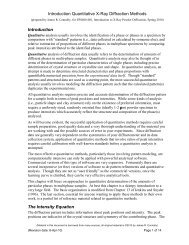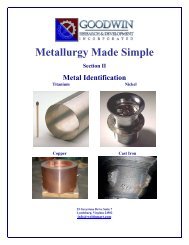ITP Metal Casting: 2002 Metal Casting Industry of the Future ...
ITP Metal Casting: 2002 Metal Casting Industry of the Future ...
ITP Metal Casting: 2002 Metal Casting Industry of the Future ...
Create successful ePaper yourself
Turn your PDF publications into a flip-book with our unique Google optimized e-Paper software.
In 2003, <strong>the</strong> <strong>Metal</strong> <strong>Casting</strong> IOF program will focus upon three research areas. These areas include:<br />
• Advanced Melting: Research in this category will establish new melting technologies and<br />
practices to dramatically improve <strong>the</strong> energy efficiency <strong>of</strong> melting. Melting represents<br />
approximately 55 percent <strong>of</strong> <strong>the</strong> overall energy costs in metal casting operations.<br />
Improvements in <strong>the</strong> melting process will have a large impact on energy consumption and<br />
cost savings for metal casters.<br />
• Innovative <strong>Casting</strong> Processes: This area <strong>of</strong> <strong>the</strong> portfolio includes research that advances<br />
energy efficient casting processes as well as practices that increase yield and reduce scrap,<br />
<strong>the</strong>reby reducing <strong>the</strong> amount <strong>of</strong> metal which must be remelted. <strong>Casting</strong> processes include, for<br />
example, lost foam, die casting, investment casting, semi-solid casting, permanent mold, and<br />
next generation ferrous castings. Innovations in <strong>the</strong>se casting processes are being made<br />
through developments in sensors, material properties and performance, computer-based<br />
modeling tools, and reduction in machining requirements.<br />
• R&D Integration and Analysis: This area <strong>of</strong> <strong>the</strong> portfolio includes research and technical<br />
assistance that integrates applicable OIT technologies for improving energy efficiency and<br />
reducing emissions in metal casting practices. Research in this area includes improvements<br />
to <strong>the</strong> general energy efficiency <strong>of</strong> plant operations through BestPractices and Industrial<br />
Assessments as well as research to identify new uses for casting byproducts.<br />
Integrated Assistance for <strong>the</strong> <strong>Metal</strong> <strong>Casting</strong> <strong>Industry</strong><br />
As illustrated in Exhibit 17, <strong>the</strong> <strong>Metal</strong> <strong>Casting</strong> IOF has funded $18 million in research with an<br />
additional $23 million provided by industry cost-share over <strong>the</strong> period <strong>of</strong> 1997 to <strong>the</strong> present.<br />
A number <strong>of</strong> o<strong>the</strong>r EERE programs have performed research related to metal casting. These<br />
include NICE 3 , Innventions & Innovations, and <strong>the</strong> Aluminum and Steel IOFs. Combined, <strong>the</strong>y have<br />
provided approximately $19 million in funding on current research and technical assistance relevant<br />
to metal casters and leveraged an additional $19 million in cost-share.<br />
Exhibit 17<br />
Leveraging Funding for <strong>the</strong> <strong>Metal</strong> <strong>Casting</strong> <strong>Industry</strong><br />
(Million Dollars)<br />
Total<br />
$42<br />
$37<br />
<strong>Metal</strong> <strong>Casting</strong> Program<br />
$23<br />
$18<br />
O<strong>the</strong>r IOF Programs<br />
(R&D related to casting)<br />
$19<br />
$19<br />
$0 $10 $20 $30 $40 $50 $60 $70<br />
$80<br />
<strong>Industry</strong> Cost Share<br />
DOE Funding<br />
17








